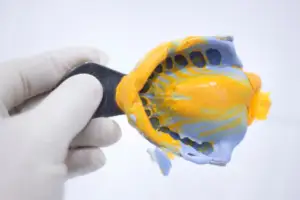Drilling fluids, commonly known as drilling muds, apply to investigation and oil and gas extraction purposes. These special fluids have multi-roles during the drilling operation. To begin with, it lubricates and cools the bit and drill string, thereby facilitating smooth and effective drilling. Then, it allows the cuttings to reach the surface through drilling while holding its hydrostatic pressure that would not cause any collapse of well or blowout of the wellbore walls. The composition of drilling fluids can vary according to the requirements within each drilling project. But as general characteristics, they are a base fluid (water, oil, or synthetic-based) in combination with a range of additives that would provide it with more improved features. This includes weigh materials, viscosifiers, shale inhibitors, fluid loss additives, and a few others that individually have a certain role in enhancing and optimizing the drilling process.
Carboxymethyl cellulose (CMC) is a derivative under the cellulose family, and chemical modification is practiced in the preparation. CMC is made upon the introduction of carboxymethyl groups (-CH2-COOH) into the cellulose chain. These modifications give CMC distinctive features of high value in most industrial application areas, among them drilling fluids. CMC, on the other hand, works as a viscosifier and fluid loss control agent in a drilling fluid system. The reason is that, due to its high viscosity, it helps in suspending and carrying the drill cuttings up to the surface. Furthermore, CMC is known to have hydrophilic properties. This property enables it to form a thin but strong film over the walls of the wellbore, hence reducing fluid loss into the surrounding formations. This feature is valuable in preserving its stability and the expensive drilling fluids.
Its thermal stability is outstanding, with excellent resistance to salts required in a high-temperature and high-salinity drilling environment, hence recognizing CMC. Another reason that makes CMC an alternative much friendlier to the environment is its non-toxic and biodegradable nature as compared to other additives of the synthetic base. Because of this reason, the oil and gas industry regards it first in its class in regard to the drilling fluid that improves the efficacy but adheres to the safety of the environment.
Historical Context of CMC in Drilling Operations
Evolution of Additives in Drilling Fluid
The development and history of additives within drilling fluid are closely intertwined with the advancement of drilling technology and the increasing complexity of oil and gas exploitation. In the early stages of oil drilling, the additives used were quite basic, consisting of plain fluids like water, mud, and natural oils. However, as drilling operations reached greater depths and encountered more challenging formations, the requirement for more specialized additives grew significantly.
Throughout the last century, drilling operations witnessed significant progress with the introduction of new additives. This included the utilization of polymers, which were initially used in other industries, to enhance wellbore stability, fluid loss resistance, and temperature tolerance. Additional substances such as clays, organic materials, and inorganic compounds were also introduced. This shift from basic drilling fluids to more complex formulations tailored for specific drilling conditions marked a major change in the industry.
The Advent of Carboxymethyl Cellulose (CMC) in Drilling Fluids
Amidst this evolution, Carboxymethyl Cellulose (CMC) emerged as a significant addition. The introduction of CMC was driven by the increasing demand for more efficient and environmentally friendly drilling fluid additives. CMC first appeared in the 20th century as a unique product with high viscosity, biodegradability, and non-toxicity, qualities that were rare in the market at that time.
The exact date of CMC’s first use in drilling fluids is somewhat uncertain, but it likely began around the mid-20th century, coinciding with the industry’s exploration of synthetic and semi-synthetic polymers for various applications. CMC was recognized for its effectiveness in controlling fluid loss and stabilizing the wellbore, essential for efficient drilling operations, particularly in adverse geological formations.
This growth in CMC usage was also influenced by increasing environmental concerns and regulations. As a naturally derived product, CMC presented a more environmentally sustainable alternative compared to many synthetic additives, aligning with the industry’s shift towards greener practices.
The introduction of CMC revolutionized drilling fluid technology, striking a balance between enhanced performance and environmental responsibility. Its versatility and compatibility with other additives led to its widespread adoption in drilling fluid formulations. Over time, the use of CMC has been refined and optimized, playing a significant role in the efficiency and safety of modern drilling practices.

Chemical Composition and Properties of CMC
Particular Emphasis on the Chemical Structure of CMC:
Carboxymethyl Cellulose (CMC) is a cellulose derivative whose unique chemical structure endows it with distinctive properties. Cellulose, a natural polymer, consists of glucose units linked by β-1,4-glycosidic bonds. In CMC, several hydroxyl groups (-OH) in the cellulose backbone are replaced with carboxymethyl groups (-CH2-COOH). This substitution, known as carboxymethylation, occurs when cellulose reacts with sodium hydroxide and chloroacetic acid.
The degree of substitution (DS) is a crucial parameter in defining CMC’s characteristics. An increased DS enhances water solubility and the ability to bind water molecules, essential properties for its use in drilling fluids. Moreover, the molecular weight of CMC influences its functionality, with higher molecular weights contributing to increased viscosity.
How the Properties of CMC Contribute to Improved Performance of Drilling Fluids:
CMC’s specialized chemical composition imparts several properties that enhance drilling fluid performance:
- Viscosity Modification: CMC is an effective viscosifier. When added to drilling fluids, it elevates their viscosity, aiding in the suspension and transport of drill cuttings from the wellbore to the surface. Controlling the fluid’s viscosity is critical for maintaining wellbore stability and reducing the risk of collapse.
- Fluid Loss Control: A primary function of CMC in drilling fluids is to minimize fluid loss. It can form a thin, robust filter cake on wellbore walls, effectively sealing and isolating the drilling fluid from penetrating the formation. This property is particularly valuable in porous formations prone to fluid loss.
- Thermal Stability: CMC retains its efficiency across a wide temperature range, a vital attribute for deep drilling where extreme heat is common. This thermal stability ensures that the drilling fluid maintains its properties even in harsh drilling conditions.
- Salt Resistance: CMC is resistant to salts, maintaining its performance in saline environments. This feature is crucial for offshore drilling operations where salt can adversely affect many other additives.
- Environmentally Safe: CMC’s biodegradable and non-toxic nature makes it an environmentally friendly option. Its use in drilling fluids aligns with the industry’s growing emphasis on reducing environmental impacts from drilling activities.
In summary, the chemical structure of CMC, characterized by carboxymethyl groups and the degree of substitution, is fundamental to its effectiveness as a drilling fluid additive. These properties—enhanced viscosity, fluid loss control, thermal stability, salt tolerance, and environmental safety—make CMC an invaluable compound for drilling operations, leading to increased performance and overall process efficiency.
CMC’s Role in Drilling Fluid Efficiency
Carboxymethyl cellulose (CMC) forms an integral part in enhancing the efficiency of drilling fluids used in drilling operations, largely in the oil and gas industry. Drilling fluids, otherwise known as drilling muds, are extremely important during the process of drilling since they provide lubrication and cooling for the drill bit, carry away drill cuttings to the surface, and protect the hydrostatic pressure required to keep the well from caving.
CMC, as a chemically modified cellulose derivative, is highly valued in drilling fluids for several reasons:
Control of Viscosity: CMC plays a key role as a viscosifier. It helps to control the drilling fluid’s viscosity. In this regard, the control of viscosity is pivotal in the carrying of the drill cuttings from the drill bit to the surface.
Filtration Control: During the drilling operation, it reduces fluid loss by forming a low-permeability filter cake on the borehole walls. This reduces fluid loss into surrounding formations.
Thermal Stability: CMC will, therefore, bear high-temperature capability, and the benefit will be that the product will be of advantageous nature since during deep operations, drilling temperatures are very high.
Compatibility: It is therefore compatible with most types of brine, together with other additives used in drilling fluids, being a commodity.
Environmental Safe Material: CMC is a cellulose derivative, hence generally environmentally friendly compared to any synthetic polymer and thus offers an excellent material for many drilling environments that may be considered environmentally sensitive.
Case Studies or Examples of CMC in Action
- Deep Water Drilling: CMC is a high-pressure and temperature-resistant polymer, so it is used to keep the properties of the drilling fluid intact. Generally, in deep water drilling, harsh conditions of temperature and pressure are encountered.
- Horizontal Drilling: In the horizontal case, control of fluid viscosity and filtration is important, since there will be more contact time compared to vertical drilling. CMC has been put to good use in maintaining the drilling fluid properties under these conditions.
- Wellbore Stability: In those fields where the geological formations are delicate, using CMC helps improve the wellbore stability. Also, the filtration control characteristic helps prevent the invasion of formation through the drilling fluid, hence maintaining stability.
- High-Pressure High-Temperature (HPHT) Wells: In HPHT, where conventional fluid fails, CMC-based fluids exhibit tenacity of viscosity and fluid loss reduction characteristics to gain traction and ensure successful completion of drilling operations.
- Environmentally Sensitive Areas: In regions or areas of operation with strict environmental regulations, the use of CMC as an additive to comply with the rule would be an added advantage. Its biodegradable nature and non-toxicity have gone a long way in minimizing the impact on the environment.
This confirms the adaptability and the efficiency of CMC under varied drilling conditions; hence, the importance of the substance toward increasing the performance of a drilling operation. The addition of CMC is customizable to the requirements of the given drilling project at hand, of which the geological conditions, environmental concerns, and technical objectives for the operation may be factors that differ.
Advantages of Using CMC in Drilling Fluids
CMC is largely used as an additive to drilling fluid because of various reasons. Let us look into some of the specific benefits of CMC compared to other additives with respect to the effect on drilling speed, stability, and safety:
Rheological Control and Stability: The addition of CMC very significantly helps to control the rheology of a given drilling fluid. It helps maintain the intended viscosity and thickness so that the fluid suspends and conveys drilling cuttings to the surface. This control over fluid properties augments drilling stability in particular, within complex geological formations.
Control of Fluid Loss: CMC is very good fluid loss control. The control of fluid loss from the borehole walls is achieved, whereby the fluid being circulated loses out after being absorbed by the rocks through which it circulates. The property is instrumental in maintaining the right hydrostatic pressure and avoiding the collapse of the borehole walls, thus increasing safety and stability.
Lubrication and Equipment Protection: Carboxymethyl cellulose is used for lubrication; hence, it reduces the frictions forces on drilling equipment. It enhances the working capacity of the equipment and reduces the risks connected with the failure of equipment, which are among the highest safety risks.
Environmental Safety: Generally, CMC is environmentally friendlier compared to some other drilling fluid additives. It is biodegradable and non-toxic; therefore, it reduces the effect on the environment from drilling operations—an ever-increasing concern from both regulatory and social standpoints.
Stability of Temperature: CMC remains effective in every sort of temperature; therefore, it can be used for drilling under different geographical and geological aspects. This assures the constant behavior of the drilling fluid.
Drilling Speed Increases: By optimizing viscosity and minimizing fluid loss, CMC should make drilling faster. Less interruption caused and better conditions to maintain should make drilling a little more efficient when borehole and equipment issues are kept to a minimum.
Compatibility with other additives includes that CMC is compatible with many other additives applied in drilling fluids. This compatibility helps design tailor-made fluid formulations with respect to specific drilling conditions that would be used for the optimization of general performance.
Cost-Effective: Though the use of CMC may be relatively costly than some other substitutes, its effectiveness in fluid loss reduction, machinery protection, and borehole stability would ensure that it saves the overall costs incurred in the drilling process.
In summary, the use of CMC in drilling fluids enables control of the rheological condition, fluid loss reduction, equipment protection, safety to the environment, and stability at any given temperature. It also speeds up the drilling process, ensuring overall cost-effective drilling operation. The foregoing benefits are of paramount importance to the efficiency, safety, and environmental impact of the operation.
Challenges and Solutions in CMC Application
But every advantage that comes with using Carboxymethyl Cellulose (CMC) in drilling fluids comes with its basket of challenges. Let us unpack these hindrances and look at radical solutions and best practices to mitigate them.
Challenges Facing the Use of CMC in Drilling Fluids
- Quality and Performance Variation: Drilling fluids vary greatly with the manufacturer and the production process, affecting its quality and performance in different drilling conditions.
- CMC Sensitivity to Temperature: Whereas at most temperatures CMC is stable, the product has the ability to be thermally degraded at high temperatures, hence causing poor control of viscosity and fluid loss.
- CMC Sensitivity to Contamination: Contamination with other components of the drilling fluid, such as salts, may impact its performance.
- Issues of Cost: High-quality CMC would, therefore, be more expensive than competing additives and raise issues of cost in drilling operations.
- Environmental Impact: Production and disposal of CMC, though biodegradable and generally considered environmentally friendly, have an environmental footprint that must be managed.
Innovative Solutions and Best Practices
- Quality Assurance and Standardization: Strict quality control, best enforced by the manufacturer, and procurement from reliable sources shall ensure uniform performance. Establishing industry standards for CMC shall also help in maintaining quality across the board.
- Advanced Formulation: The problem faced in high-temperature drilling environments can be eliminated by developing advanced CMC formulations that have more temperature resistance.
- Compatibility Testing: Proper testing for compatibility with other additives, as well as salts that exist within the drilling environment, will keep unexpected performance problems from cropping up.
- Cost-Benefit Analysis: Though the initial cost of CMC may be higher, the overall benefits in terms of efficiency and equipment protection could outweigh this cost. A comprehensive cost-benefit analysis would bring out the facts.
- Eco-Friendly Production Processes: Through the adoption of nature-based green technologies and investment in eco-friendly processes of CMC production and disposal, the overall environmental impact shall have a major reduction.
- Training and Education: Education of the personnel regarding the best use of CMC in drilling fluid by giving them necessary training will result in extracting maximum benefit while eliminating associated problems.
- Research and Development: Continuous research for the improvement in properties of CMC with cost reduction in its production is another way forward to overcome many existing challenges.
- Working with Industry Experts: Collaboration with industry experts and academia may provide innovative solutions and the best practices in the CMC application. This has to be combined with a strict drive for technical innovation, best practice, and collaborative efforts to ensure that CMC applications continue to rise and drive higher effectiveness and sustainability in drilling operations.
Environmental Impact and Sustainability of CMC
Thus, cellulose ethers, such as Carboxymethyl cellulose (CMC), find application across industries. They are used as an additive to drilling fluids during oil and gas extraction. It can be judged for their environmental impact and role in sustainability, especially with drilling practices, on various criteria, which include:
Biodegradability: CMC is made from natural cellulose and is generally considered to be biodegradable. This characteristic might reduce the environmental impact, which is seen over the long term, because CMC-containing drilling fluids will break down more readily in the environment than those composed of synthetic polymers.
Non-toxicity: The nature of CMC is usually non-toxic, which is an essential criterion vis-à-vis drilling operations. Usage of non-toxic materials helps to minimize the harmful impact on the ecosystem in the event of an accidental release during various activities associated with drilling.
Efficiency in Drilling Operations: CMC is used in drilling fluids to improve certain characteristics of the same, among them viscosity and water-retaining capacity. This may allow a more efficient drilling operation, shortening the time and resources that are necessary for the drilling activity and, therefore, at the end of the line, its overall environmental footprint.
Reduction in Formation Damage: CMC contributes to a decrease in the damage required to the geological formation being drilled. This is important for the ecosystem’s integrity and, therefore, a part of sustainable drilling.
Water-Based Drilling Fluids: CMC mainly finds application in water-based drilling fluids, known to be friendlier compared to other drilling fluids, such as oil-based ones. With its additive CMC, the usage of water-based fluids is one step in the sustainability of drilling.
Regulatory Compliance: Most regions apply strict environmental regulations, which encompass the discharge of drilling fluids. The addition of environmentally benign additives like CMC will assist them in coming under regulatory compliance.
Carbon Footprint: From production through transportation to the point of use and subsequent use in drilling activity, there is a carbon footprint at every level. Thus, the lifecycle perspective is important to comprehend the overall carbon footprint of CMC.
Resource Utilization: The sourcing cellulose raw material should be ensured to come from sustainable forestry practices. This would guarantee that there is no deforestation occurring or any other kind of harmful environmental practice being used for producing CMC.
Waste Management and Recycling: In this context, the drilling fluids disposed of, containing CMC, must be disposed of in an environmentally responsible way. Opportunities should be looked into for recycling or repurposing these materials in order to improve their sustainability profile.
Alternative Technologies and Innovation: There is ongoing research to develop alternative and more sustainable drilling fluid additives. While CMC has currently an important role in sustainability, innovation and development may result in a better, more environmentally friendly solution.

Cost-Benefit Analysis of CMC in Drilling Fluids
In this view, cost-benefit analysis of the use of Carboxymethyl cellulose (CMC) in drilling fluids works through several economic considerations, which could calculate the Return on Investment (ROI) accruing to the companies. Herein discussed are these economic considerations:
The Economic Case for Using CMC in Drilling Fluids
Initial and Ongoing Cost Considerations:
- Purchase Cost: The purchase cost of CMC vis-à-vis other drilling fluid additives.
- Storage and Handling: Any differential nature while storage and handling compared to other additives.
- Usage Rate: Quantities per operation versus the next best alternative.
Operational Efficiency Considerations:
- Drilling Speed: Improved fluid properties by CMC may lead to a better drilling speed and decreased operational time.
- Fluid Loss Control: Efficient control of fluid loss may translate into fewer costs in terms of additional fluid or treatment.
Maintenance and Equipment Longevity:
- Wearing and Tearing: CMC may cause the wearing and tearing of drilling equipment, although this could reduce maintenance costs.
- Equipment Efficiency: Better equipment efficiency due to improved lubrication properties.
Environmental Compliance:
- Regulatory Compliance Costs: Saving on reduced fees or penalties against environmental impacts.
- Disposal Costs: Removal costs for drilling fluids.
Risk Mitigation:
- Reduced Risk of Accidents: Probable saving against a lesser risk of any accident or spill related to drilling.
ROI Analysis of Integration of CMC into the Drilling Operation:
Benefit Quantification:
- Increased Efficiency: Determine the time saved and the value of increased productivity.
Cost Quantification:
- Direct Costs: The cost of purchasing CMC and additional equipment.
- Indirect Costs: Training, likely downtime in the integration, and changes in operational procedures.
Factors to be taken into account during the analysis:
- Market Variables: Prices fluctuating for CMC and other drilling additives.
- Operational Variables: Drilling practices in changes from site to site; geological conditions vary, fluid needs for drilling.
- Long-term Impact: This may include the fact that the company may enjoy long-term savings from environmental sustainability and the possible regulatory differences in the future.
Future Trends and Innovations in CMC Usage
To explain its versatile nature, CMC is widely applied in many industries, including as a component of drilling fluid. In drilling fluids, CMC is specifically applied to increase functions such as controlling viscosity, control filtration, and stabilization of the fluid in the drilling system. Let us discuss some of the emerging trends and future possible innovations in the use of CMC in drilling fluids:
Green and Sustainable Alternatives: A trend in the direction of green drilling practices is visible nowadays. Future innovations would consider developing types of CMC that are more biodegradable and greener with lesser environmental impact, though its functional properties are not completely lost.
Improved Thermal Stability: Drilling operations have moved to more extreme conditions such as deeper wells and higher temperatures. Future CMC products might be designed with enhanced thermal stability in order to have the ability to withstand such rough properties given off in these environments.
Betterment in Filtration Control: The functionality of CMC in drilling fluids is very crucial for better filtration control. Such innovations can lead to further new formulations with improved filtration control to reduce fluid loss and optimize drilling efficiency.
Customized CMC Products: The customization may be the call of the day for tailor-made CMC products that cater specifically to drilling conditions like high-pressure high-temperature (HPHT), saline, and sweet spots or unconventional reservoirs.
Integration with Nanotechnology: Integration of CMC with nanotechnology could result in drilling fluid systems having enhanced properties. The nano-enabled CMC systems may provide an added advantage of giving extra control over the fluid viscosity, filtration of the fluid, and cuttings suspension.
Smart Drilling Fluids: In addition to all these, an innovative upcoming product would be smart drilling fluids. CMC may be one of the upcoming responsive systems that can be turned off to perform its action under temperature, pressure, or pH.
Improved Compatibility of CMC with Other Fluid Additives: With the drilling fluid formulation getting more complicated, it is a must that improved compatibility is ensured between all the ingredients. Innovations for CMC may include making it more compatible with other fluid additives to minimize or eliminate cases of precipitation or phase separation.
Economically Viable Production Cost and Sourcing: Innovations might not only come on the front of functionalities of CMC but also its production with more cost-effective methods or sourcing raw material, which makes it more economically viable for much prevalent use in drilling operations.
Advancement in Rheology Control: Improved rheological control for optimized fluid performance over a wide range of flow conditions is among the targeted areas of innovation for CMC.
Integrated with Digital Monitoring Systems: With increasing levels of digitalization in drilling, future use of CMC might be optimized through data analytics in real time and monitoring systems, helping in making dynamic adjustments to the properties of drilling fluid as and when required.
With these trends come potential innovations that could be part of a bigger movement toward more efficient, environmentally sustainable, and flexible practices in drilling, with CMC being an important part of that effort.





